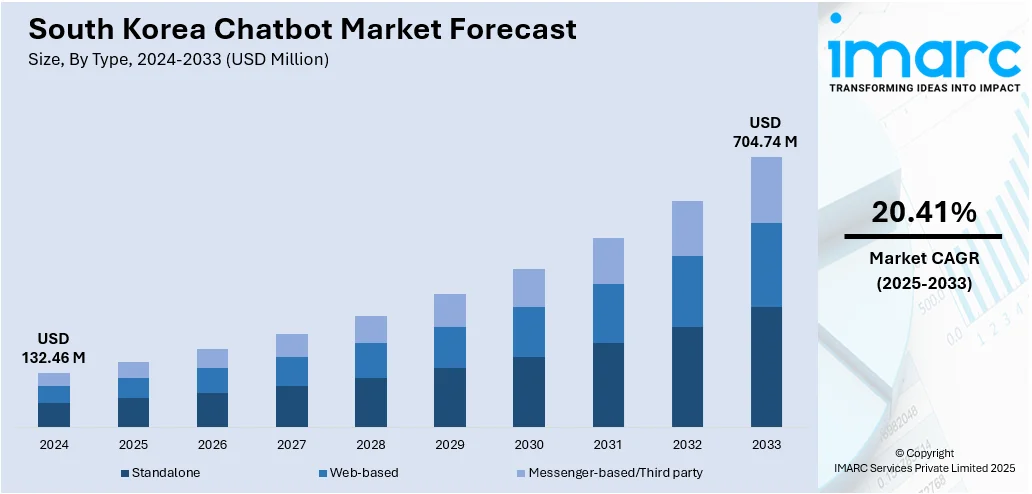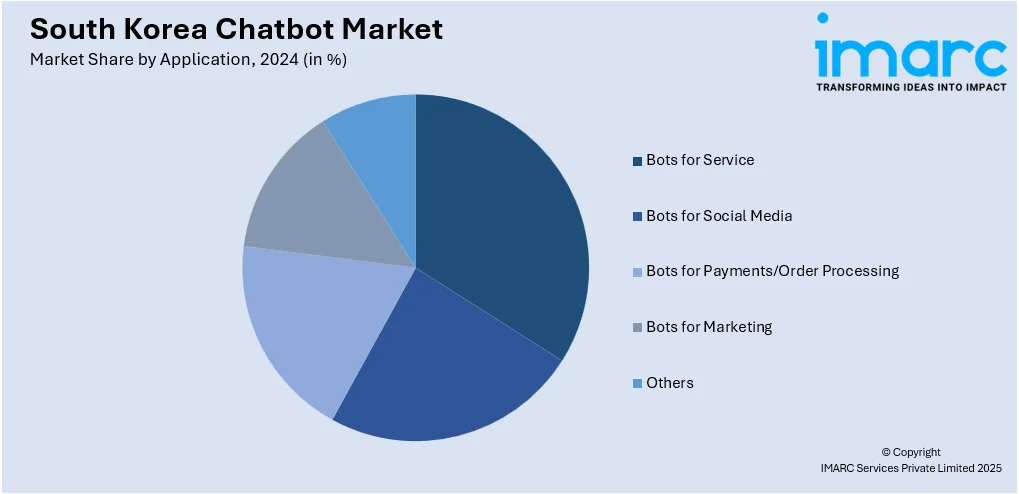
South Korea Chatbot Market Size, Share, Trends and Forecast by Type, Product, Application, Organization Size, Vertical, and Region, 2025-2033
South Korea Chatbot Market Overview:
The South Korea chatbot market size reached USD 132.46 Million in 2024. Looking forward, the market is expected to reach USD 704.74 Million by 2033, exhibiting a growth rate (CAGR) of 20.41% during 2025-2033. The market is driven by its highly connected population, strong mobile infrastructure, and widespread use of messaging platforms like KakaoTalk. Businesses across finance, healthcare, retail, and public services are adopting chatbots to improve customer engagement and reduce operational costs. The tech-inclined culture, along with innovation driven by domestic tech giants, guarantees consistent adoption and advancements in chatbot applications, further increasing the South Korea chatbot market share substantially.
|
Report Attribute
|
Key Statistics
|
|---|---|
|
Base Year
|
2024
|
|
Forecast Years
|
2025-2033
|
|
Historical Years
|
2019-2024
|
| Market Size in 2024 | USD 132.46 Million |
| Market Forecast in 2033 | USD 704.74 Million |
| Market Growth Rate 2025-2033 | 20.41% |
South Korea Chatbot Market Trends:
Growing Adoption through National Digital Culture and Infrastructure
The chatbot market in South Korea is rapidly growing, influenced by the nation's developed digital infrastructure and digitally conscious citizenry. One of the highest rates of internet and smartphone penetration in the world, South Koreans are highly integrated into digital ecosystems in which instant communication is taken for granted. Daily interactions are dominated by messaging platforms such as KakaoTalk, and companies are moving more and more to embedding chatbots into such platforms to address consumer need for quick, 24/7 service. Chatbots are used by retailers, telecommunication providers, and e-commerce sites for everything from tracking orders to suggesting products. South Korean consumers are used to smooth, individualized engagement, leading businesses to embrace more intuitive, adaptive chatbot systems. In addition, the adoption of voice-enabled AI in smart speakers and mobile apps is increasing the use of chatbots beyond text-based services. This customer-driven desire for real-time interaction is a key trend shaping the market, as chatbots become a routine component of digital service strategies for both private and public sectors.

To get more information on this market, Request Sample
Enterprise Adoption in Finance and Healthcare and Public Services
Enterprise adoption of chatbots is speeding up across South Korea as businesses pursue operational efficiency and enhanced customer interaction. Financial institutions are at the forefront, with large banks and fintech companies using chatbots for customer onboarding and fraud notifications and real-time money management advice. These bots manage high numbers of queries, enabling human personnel to concentrate on complex operations with high standards of service. In the healthcare sector, hospitals and clinics employ chatbots for appointment booking, patient registration, and initial symptom assessment, in sync with the nation's overall drive toward digital healthcare solutions. Chatbot technology is also being accepted in the public sector to increase accessibility to government services. Local authorities and state agencies currently provide AI-driven support via websites and applications, making citizens able to navigate services more effectively. Increasing confidence in artificial intelligence and automation, underpinned by strong digital infrastructure, is driving the South Korea chatbot market growth and application in key industries, and thus enterprise adoption is one of the most influential trends in the market.
Growth of Sophisticated NLP, Government Support for AI, and Cultural Acceptance
One of the distinguishing trends in South Korea's chatbot industry is the development of natural language processing (NLP) technologies specific to the Korean language. In contrast to much of the international chatbot technology centered on English, Korean-language bots are being designed to interpret rich grammar, formal speech, and local dialects. Local tech companies are putting a lot of resources into this segment, allowing for more natural-sounding and culturally sensitive chatbot interactions. Support from the government also comes into play, with national programs that encourage research and development of artificial intelligence. Such programs finance domestic startups, AI labs, and joint projects directed at enhancing chatbot intelligence and user experience. Integration of chatbots with education, entertainment, and smart city infrastructure is another driving trend, with bots helping out with student services to real-time traffic information. This culturally nuanced, government-backed innovation is pushing the boundaries of chatbot functionality in South Korea, positioning the country as a leader in conversational AI within Asia.
South Korea Chatbot Market Segmentation:
IMARC Group provides an analysis of the key trends in each segment of the market, along with forecasts at the country and regional levels for 2025-2033. Our report has categorized the market based on type, product, application, organization size, and vertical.
Type Insights:
- Standalone
- Web-based
- Messenger-based/Third party
The report has provided a detailed breakup and analysis of the market based on the type. This includes standalone, web-based, and messenger-based/third party.
Product Insights:
- Artificial Intelligence
- Marketing
- Human Intelligence
The report has provided a detailed breakup and analysis of the market based on the product. This includes artificial intelligence, marketing, and human intelligence.
Application Insights:

- Bots for Service
- Bots for Social Media
- Bots for Payments/Order Processing
- Bots for Marketing
- Others
The report has provided a detailed breakup and analysis of the market based on the application. This includes bots for service, bots for social media, bots for payments/order processing, bots for marketing, and others.
Organization Size Insights:
- Small Enterprises
- Medium Enterprises
- Large Enterprises
A detailed breakup and analysis of the market based on the organization size has also been provided in the report. This includes small enterprises, medium enterprises, and large enterprises.
Vertical Insights:
- Healthcare
- Retail
- Banking, Financial Services, and Insurance
- Media and Entertainment
- Travel and Tourism
- E-commerce
- Others
The report has provided a detailed breakup and analysis of the market based on the vertical. This includes healthcare, retail, banking, financial services, and insurance, media and entertainment, travel and tourism, e-commerce, and others.
Regional Insights:
- Seoul Capital Area
- Yeongnam (Southeastern Region)
- Honam (Southwestern Region)
- Hoseo (Central Region)
- Others
The report has also provided a comprehensive analysis of all the major regional markets, which include Seoul Capital Area, Yeongnam (Southeastern Region), Honam (Southwestern Region), Hoseo (Central Region), and others.
Competitive Landscape:
The market research report has also provided a comprehensive analysis of the competitive landscape. Competitive analysis such as market structure, key player positioning, top winning strategies, competitive dashboard, and company evaluation quadrant has been covered in the report. Also, detailed profiles of all major companies have been provided.
South Korea Chatbot Market News:
- In February 2025, reports indicated that one in ten Koreans utilize AI Wrtn, a local variant of ChatGPT created by Wrtn Technologies. Launched in March 2023, the AI chatbot boasts more than five million active users each month. The firm has sped up its international expansion by securing a total of KRW 48 billion in funding from Silicon Valley in the US and top domestic and foreign venture capital firms. Wrtn is an AI portal that provides free and unlimited access to generative AI all in one place. It quickly integrates advanced international services like GPT-4o, Stable Diffusion 3, and Claude 3 as they become available and facilitates their application via localization.
South Korea Chatbot Market Report Coverage:
| Report Features | Details |
|---|---|
| Base Year of the Analysis | 2024 |
| Historical Period | 2019-2024 |
| Forecast Period | 2025-2033 |
| Units | Million USD |
| Scope of the Report |
Exploration of Historical Trends and Market Outlook, Industry Catalysts and Challenges, Segment-Wise Historical and Future Market Assessment:
|
| Types Covered | Standalone, Web-based, Messenger-based/Third Party |
| Products Covered | Artificial Intelligence, Marketing, Human Intelligence |
| Applications Covered | Bots for Service, Bots for Social Media, Bots for Payments/Order Processing, Bots for Marketing, Others |
| Organization Sizes Covered | Small Enterprises, Medium Enterprises, Large Enterprises |
| Verticals Covered | Healthcare, Retail, Banking, Financial Services, and Insurance, Media and Entertainment, Travel and Tourism, E-commerce, Others |
| Regions Covered | Seoul Capital Area, Yeongnam (Southeastern Region), Honam (Southwestern Region), Hoseo (Central Region), Others |
| Customization Scope | 10% Free Customization |
| Post-Sale Analyst Support | 10-12 Weeks |
| Delivery Format | PDF and Excel through Email (We can also provide the editable version of the report in PPT/Word format on special request) |
Key Questions Answered in This Report:
- How has the South Korea chatbot market performed so far and how will it perform in the coming years?
- What is the breakup of the South Korea chatbot market on the basis of type?
- What is the breakup of the South Korea chatbot market on the basis of product?
- What is the breakup of the South Korea chatbot market on the basis of application?
- What is the breakup of the South Korea chatbot market on the basis of organization size?
- What is the breakup of the South Korea chatbot market on the basis of vertical?
- What is the breakup of the South Korea chatbot market on the basis of region?
- What are the various stages in the value chain of the South Korea chatbot market?
- What are the key driving factors and challenges in the South Korea chatbot market?
- What is the structure of the South Korea chatbot market and who are the key players?
- What is the degree of competition in the South Korea chatbot market?
Key Benefits for Stakeholders:
- IMARC’s industry report offers a comprehensive quantitative analysis of various market segments, historical and current market trends, market forecasts, and dynamics of the South Korea chatbot market from 2019-2033.
- The research report provides the latest information on the market drivers, challenges, and opportunities in the South Korea chatbot market.
- Porter's five forces analysis assist stakeholders in assessing the impact of new entrants, competitive rivalry, supplier power, buyer power, and the threat of substitution. It helps stakeholders to analyze the level of competition within the South Korea chatbot industry and its attractiveness.
- Competitive landscape allows stakeholders to understand their competitive environment and provides an insight into the current positions of key players in the market.
Need more help?
- Speak to our experienced analysts for insights on the current market scenarios.
- Include additional segments and countries to customize the report as per your requirement.
- Gain an unparalleled competitive advantage in your domain by understanding how to utilize the report and positively impacting your operations and revenue.
- For further assistance, please connect with our analysts.
 Request Customization
Request Customization
 Speak to an Analyst
Speak to an Analyst
 Request Brochure
Request Brochure
 Inquire Before Buying
Inquire Before Buying




.webp)




.webp)












